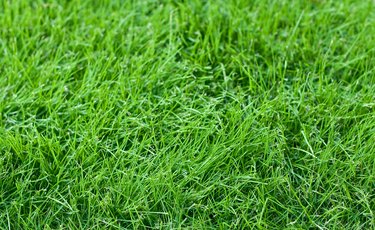
Both bermudagrass and fescue can be used for a lawn, but they differ substantially in their appearance and growth habits. Fescues have relatively fine leaves and perform well in areas where winters are cold. Bermudagrass has a coarser texture, is better suited to warm climates and has an aggressive growth habit that can get out of control if not managed properly. When planting grass, consider your climate first off, then the conditions in your particular yard.
Warm-Season Bermudagrass Turf
Video of the Day
Bermudagrass (Cynodon spp.), a warm-season grass, grows in the area that roughly covers U.S. Department of Agriculture plant hardiness zones 7 through 10. It's a fast-growing, medium-textured grass that's widely used in lawns in the southern U.S. Bermudagrass spreads actively, and it readily fills in bare spots in the lawn.
Video of the Day
It's also heat-, disease- and drought-tolerant, and it forms a lawn that is dense and resistant to erosion. Bermudagrass does not grow well in shade, and it goes dormant and turns brown after a frost. Bermudagrass should be mowed to between 1 1/2 and 2 1/2 inches.
Cool-Season Fescue Turf
Fine fescue (Festuca spp.) and tall fescue (Festuca arundinacea) are cool-season turf grasses that grow as perennial grasses in USDA zones 2 through 7. They are fine-textured, dark green grasses that do well in cooler climates. Both types of fescues are drought-tolerant, and fine fescue also tolerates shade better than many other cool-season turf grasses.
Tall fescue handles heat well, but it does not do as well in shade as fine fescue. Fescues should be mowed 2 1/2 to 4 inches high. Fescues are susceptible to fungal diseases, and they are most vulnerable when they are fertilized with too much nitrogen.
Invasiveness of Bermudagrass
The downside of bermudagrass' tendency to spread is that it may become invasive if it's not contained, a problem so significant that bermudagrass is considered an invasive weed in some parts of the country, as it thrives in a wide range of habitats.
Bermudagrass spreads through both underground rhizomes and above-ground stolons, and turf that's not contained by edging will likely spread into garden beds and paved areas. The edging needs to extend at least 6 inches beneath the surface of the soil to prevent the spread of rhizomes. Bermudagrass can be a particular problem when it invades lawns made up of other grasses, such as fescues, because it's difficult to eradicate the bermudagrass without damaging the other grasses.
Controlling Bermudagrass in Fescue Turf
Prevention is one of the best ways to keep your fescue lawn free of bermudagrass. Raising the mowing height of the fescue can help by increasing the strength and density of the grass and also by shading out any low-growing bermudagrass that has made its way into the lawn. Water deeply, so the soil is moist to a depth of 6 inches, but only water once a week — watering more frequently and shallowly will benefit the bermudagrass more than the fescue.
Check any soil or compost you introduce into your lawn for bermudagrass rhizomes and stolons to avoid contaminating the lawn, and keep garden beds free of bermudagrass so they don't provide an entry point into your lawn.